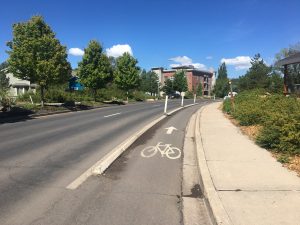Metroplan Flagstaff discusses ways to reduce annual miles traveled.
What will it take for the city to achieve its stated carbon neutrality goal? Metroplan Flagstaff is the regional transportation planning agency comprised of partners from the City of Flagstaff, Coconino County, Arizona Department of Transportation, Mountain Line (NAIPTA) and Northern Arizona University. It made a detailed study of this issue in an initiative called “Stride Forward.”
“We evaluated two scenarios to see what it would take to get to carbon neutrality in the region by 2030,” said Metroplan Executive Director Kate Moreley. “The first one, called ‘Onward,’ implements road improvements funded by Propositions 403, 419 and 420, staying within currently available budgets. Under that scenario, vehicle miles traveled will increase by 460,000 miles per day. That’s 20% above 2019 levels and will mean a similar increase in carbon emissions, unless there’s a sudden and significant shift to electric vehicles.”
The alternative “Upward” scenario presents a blueprint for how to maintain the total number of vehicle miles traveled at 2019 levels of 2.36 million miles per day, with a goal to eventually reduce it, she said. “’Upward’ is what we call an illustrative concept, with more significant, connected biking and walking infrastructure and increased public transit.”
To do this is not inexpensive. “Our analysis indicates that to make walking and cycling attractive enough to meet carbon neutrality goals, we’d need a doubling of current transit investments and a one-time investment to quadruple the biking and pedestrian infrastructure [sidewalks, bike paths, safe crossings]. The estimated cost is $394 million,” said Moreley. “At the present time, there’s no funding for this.” See September FBN story, “Flagstaff’s Transportation Future, Part One.”
The revenues being generated by sales tax through Prop 419 and Prop 420 are already dedicated to planned roadway infrastructure improvements, which do involve significant bike and pedestrian path provisions. There have already been modifications to some existing roads – such as on Butler Ave., where a barrier was introduced to separate the bike lane and give cyclists more protection.
Since installation, the city has removed some short sections of that barrier, though. “They were difficult to maintain and there were lot of car hits in those areas,” said City of Flagstaff Traffic Engineer Jeffrey Bauman. “On those sections we’ve re-striped the road and painted a buffered lane instead. We’re also experimenting with traffic-slowing measures on some arterial roads where safety is a concern. For example, testing raised crosswalks at intersections on Highland Mesa and Woody Way, to see if they’re effective and can work with snow plowing and street sweeping operations.”
“The $1 million spent on pilot projects to improve bike lanes on Butler Ave. and Beaver St. seems expensive,” said Adam Shimoni, a board member for Flagstaff Biking Organization. “But projects like this cost only a fraction of the spending that the Lonetree Corridor and South Milton underpass projects will entail. I’d rather see us working towards the ‘complete streets’ concept, which slows cars down, creating safer spaces and a better quality of life for all.”
But driving is an engrained mode of transit for most. Metroplan’s 2018 Flagstaff Trip Diary Survey of Community Travel Patterns showed that respondents typically made five private vehicle driving trips with an average trip length of four miles per day; more than a third (37%) of those trips were less than 2.5 miles. This demonstrates that there is great potential for people to walk or bike, at least some of the time.
But safety is a key issue. The same Trip Diary Survey showed 41% of respondents were disincentivised to cycle in current conditions for fear of a bike crash, with bad weather and distance being subsidiary factors. The school commute is another area with potential for more walking or cycling – currently 60% of children are driven to school and 33% use a school bus, while only 9% of children walk to school and few cycle.
“The conversation is starting to shift,” said Moreley. “There are already some small incentive programs, like the $150,000 per year for schools to promote safe routes so that kids can bike or walk themselves to school. But to implement the ‘Upward’ plan, funding will need to come from outside existing sources.”
Unless that funding can be found, Flagstaff’s stated goal of carbon emissions neutrality in the transportation sector will not be coming any time soon – and certainly not by 2030. FBN
By Diane Hope, FBN
For more information, visit https://www.metroplanflg.org/strideforward or https://www.metroplanflg.org/flagstaff-trip-diary-survey.
Courtesy Photo: To make walking and cycling attractive enough to meet carbon neutrality goals, the City of Flagstaff may need to double current transit investments and quadruple the biking and pedestrian infrastructure including sidewalks and bike paths, according to Metroplan Flagstaff.







